#euarchontoglires
Explore tagged Tumblr posts
Text

Apatemyids were a group of unique early placental mammals that lived during the first half of the Cenozoic, known from North America, Europe, and Asia. Due to their specialized anatomy their evolutionary relationships are rather murky (they were traditionally part of the convoluted mess that was "Insectivora"), but currently they're thought to be a very early offshoot of the Euarchontoglires, the branch of placentals that includes modern rodents, lagomorphs, treeshrews, colugos, and primates.
Living in what is now western Europe during the mid-Eocene, around 47 million years ago, Heterohyus nanus was a small apatemyid about 30cm long (~12") – although just over half of that length was made up of its tail.
Like other apatemyids it had a proportionally big boxy head, with large forward-pointing rodent-like incisors in its lower jaw and hooked "can-opener-shaped" incisors in its upper jaw.

Example of an apatemyid skull from the closely related American genus Sinclairella. From Samuels, Joshua X. "The first records of Sinclairella (Apatemyidae) from the Pacific Northwest, USA." PaleoBios 38.1 (2021). https://doi.org/10.5070/P9381053299
The rest of its body was rather slender, and fossils with soft tissue preservation from the Messel Pit in Germany show that it had a bushy tuft of longer fur at the end of its long tail.
But the most distinctive feature of apatemyids like Heterohyus were their fingers, with highly elongated second and third digits resembling those of modern striped possums and aye-ayes. This suggests they had a similar sort of woodpecker-like ecological role, climbing around in trees using their teeth to tear into bark and expose wood-boring insect holes, then probing around with their long fingers to extract their prey.
———
NixIllustration.com | Tumblr | Patreon
References:
Kalthoff, D. C., W. Von Koenigswald, and C. Kurz. "A new specimen of Heterohyus nanus (Apatemyidae, Mammalia) from the Eocene of Messel (Germany) with unusual soft part preservation." Courier Forschungsinstitut Senckenberg 252 (2004): 1-12. https://www.researchgate.net/publication/263714512_A_new_specimen_of_Heterohyus_nanus_Apatemyidae_Mammalia_from_the_Eocene_of_Messel_Germany_with_unusual_soft-part_preservation
Koenigswald, W. V., and H-P. Schierning. "The ecological niche of an extinct group of mammals, the early Tertiary apatemyids." Nature 326.6113 (1987): 595-597. https://www.researchgate.net/publication/232761846_The_ecological_niche_of_early_Tertiary_apatemyids_-_extinct_group_of_mammals
Samuels, Joshua X. "The first records of Sinclairella (Apatemyidae) from the Pacific Northwest, USA." PaleoBios 38.1 (2021). https://doi.org/10.5070/P9381053299
Silcox, Mary T., et al. "Cranial anatomy of Paleocene and Eocene Labidolemur kayi (Mammalia: Apatotheria), and the relationships of the Apatemyidae to other mammals." Zoological Journal of the Linnean Society 160.4 (2010): 773-825. https://doi.org/10.1111/j.1096-3642.2009.00614.x
#science illustration#paleontology#paleoart#palaeoblr#heterohyus#apatemyidae#apatotheria#euarchontoglires#mammal#art#convergent evolution#exceptional preservation#it's like if a rat tried to become an aye-aye
211 notes
·
View notes
Text
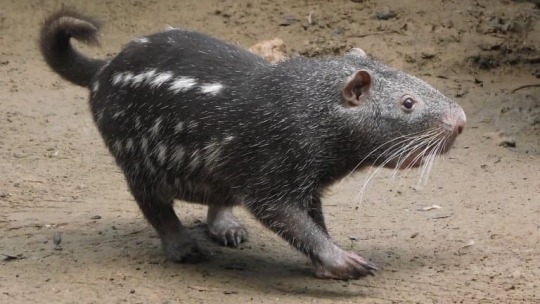
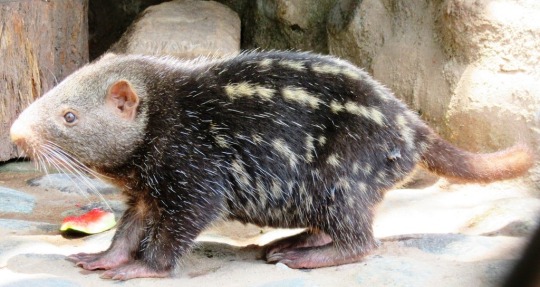
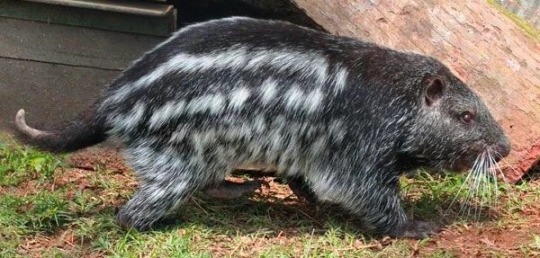
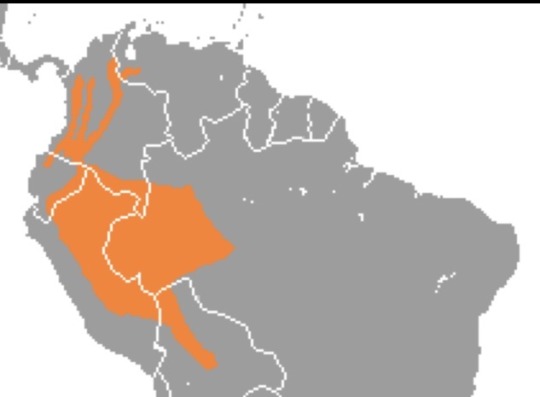
Pacarana
Dinomys branickii
Family Dinomyidae, pavorder Caviomorpha, suborder Hystricomorpha, order Rodentia
This animal is called the pacarana because it looks a bit like a paca, another South American rodent.
They are the only living member of their taxonomic family. Some other members of this family grew to incredible sizes, like the bison sized Josephoartigasia, which is the largest known rodent. Pacaranas themselves are pretty large, weighing as much as 15 kg, or 33lbs.
Pacaranas are very slow moving and peaceful animals. They eat fruits, leaves, and stems of plants and eat sitting down while holding their food like they have hands. It’s very cute.
The males also stand on their hind legs when approaching females during courtship and there was a viral video of one of these guys standing on their hind legs a while back trying to remove soap from their fur. It has been confirmed by an expert that no, you should not put soap on a pacarana.
They’re mainly nocturnal and terrestrial, but they do a bit of climbing.
These animals are vulnerable to becoming endangered.
@jackalspine @fifiibibii
68 notes
·
View notes
Text
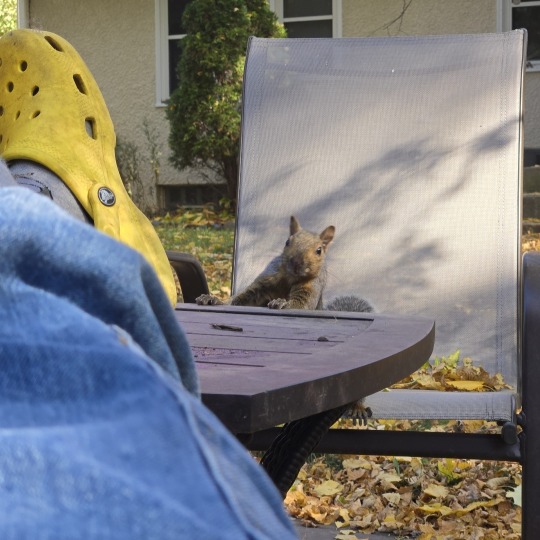
tea time with the euarchontoglires squad no laurasiatherians allowed
2 notes
·
View notes
Text

2 notes
·
View notes
Text
I think about how cute monkeys are and forget I have pet rats which are basically monkey adjacent.
6 notes
·
View notes
Text
found a decapitated wild rabbit in a neighbor’s yard, pics under the cut
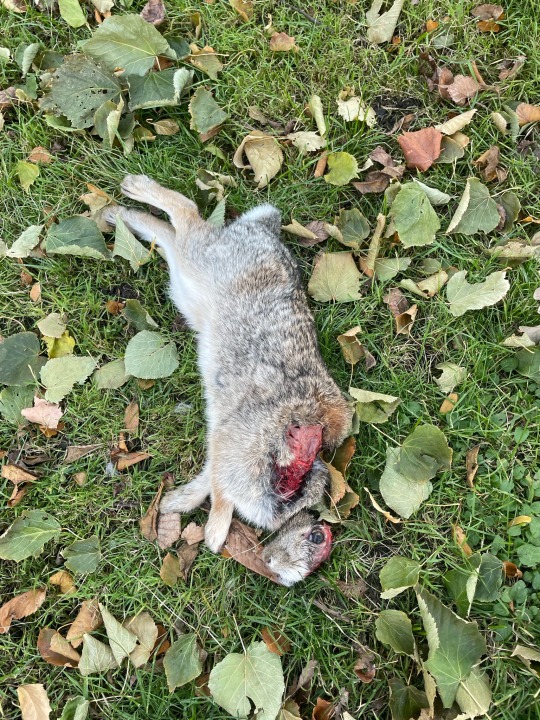
#chordata#sarcopterygii#tetrapoda#amniota#synapsida#mammalia#theria#eutheria#boreoeutheria#euarchontoglires#glires#lagomorpha#leporidae#ok that’s enough clades#won’t bother with all those in the future just having fun with them#oh also#animal death#that guy is super dead
0 notes
Text
i think nearly everything about human behavior can be explained by our evolutionary background. if we observe the entire tree of mammal phylogenetics we can see that the glires clade (rodents and lagomorphs) and euarchonta (primates, colugos and treeshrews) are grouped into one superorder called euarchontoglires, meaning humans are also technically tree dwelling mice as far as semantics are concerned. anyways there are a lot of morphological similarities one can observe between rodents and primates, namely hands, and using those hands to hold onto something like a sunflower seed or a sandwich and nibble on it while sitting in a comfortable spot. like primates the ears, hands and feet of rodents are also relatively hairless, and they are also hypersocial and studies on rats have suggested they feel empathy and will act upon it. in fact a lot of rat behavior resembles human behavior to the point that many behavioral studies are done on them in order to understand the effects/causes of addiction and isolation etc. of course all these traits developed independently but one could argue that A) the basal form that euarchontoglires originated from was already predisposed to these traits or B) already had some or all these traits in varying quantities and other groups like lagomorphs actually lost them. so the homo genus finally developing visual art as one of the culminations of animal creativity/dexterity and immediately using that skill to animate little rodent people wearing clothes and living in societies parallel to our own over and over and over and over until we are sick of seeing them and wondering wtf is going on just makes perfect sense evolutionarily speaking. it was meant to be
205 notes
·
View notes
Text
Shout out to convergent evolution!
Always recreating lil' guys!

Not a hedgehog
Lesser hedgehog tenrec (Echinops telfairi). More closely related to elephants than to hedgehogs.




Not rodents (and also not remotely related to each other) Pictured from left to right:
Yellow-footed antechinus (Antechinus flavipes) or mardo. A marsupial. Relatives include the tasmanian devil. So closer to a koala or kangaroo than to rodents.
Lesser white-toothed shrew (Crocidura suaveolens). Despite their similar appearance and often sharing habitats with rodents granted, rodents are basically everywhere, shrews are not rodents. They are more closely related to moles and hedgehogs
Mountain treeshrew (Tupaia montana). Not a shrew either, despite its name. Out of these four lil guys, treeshrews are the most closely related to rodents, but they're still not rodents. Rabbits and hares are more closely related to rodents than treeshrews are.
Bushveld elephant shrew (Elephantulus intufi). Also not a shrew. Elephant shrews are related to tenrecs and thus also more closely related to elephants than to rodents or shrews. So the first part of their name is actually closer to accurate than the second part.
speaking of shrews

this is not a shrew either. Or a rodent.
Eastern caenolestid (Caenolestes sangay) is a shrew possum. Which are not shrews. They are marsupials, but whether they're technically possums I'll leave up to people more knowledgeable about the subject (but feels like a case of semantics to me). Closest living relatives are the other american opossums, though shrew possums belong to a seperate order.



Not moles (these three are not remotely closely related to each other either)
Taiwanese mole shrew (Anourosorex yamashinai)...now we're back to actual shrews.
Hottentot golden mole (Amblysomus hottentotus). Aah, Afroinsectivora strikes again. Golden moles belong to the same clade as tenrecs and elephant shrews, so once again we have a little guy more closely related to elephants than to moles (or shrews or rodents or hedgehogs).
Southern marsupial mole (Notoryctes typhlops) or itjaritjari. As the first part of the name suggests, this is a marsupial aka more closely related to a kangaroo than to a mole.


Not flying squirrels (or rodents at all)
Sugar glider (Petaurus breviceps). Another marsupial. Outside of its genera, closest relatives include the great gliders, honey possum, and the feathertail glider.
Philippine flying lemur, Philippine colugo, or kawang (Cynocephalus volans). Not a rodent or lemur, though more closely related to the latter (but still not that close). Colugos belong to their own order, with wet-nosed primates (aka lemurs, tarsiers, lorises etc) and the earlier mentioned treeshrews being their closest living relatives. Which granted makes them more closely related to rodents than most animals listed here.
Side note: despite having "flying" in their names, there are no mammals except bats that can actually fly.
Fun fact! The superorder Euarchontoglires includes 5 groups of animals: rodents, lagomorphs (rabbits & hares), treeshrews, colugos and primates. So excluding the treeshew and colugo, humans are more closely related to rodents than any other animal listed here.
Anyway, here is a monito del monto with a bunch of kiddos

#animals#.....man I should tag this but I'm tired so maybe later#also there are so many more animals that look like rodents or something along those lines that are not rodents
10 notes
·
View notes
Text
euarchontoglires
(rodents, lagomorphs, primates, tree shrews, and colugos)
6 notes
·
View notes
Text
So the Preliminary SVP Schedule got released
For those unfamiliar, SVP = Society of Vertebrate Paleontology
usually when paleontologists say "SVP" they mean specifically the conference that SVP hosts each year, one of the biggest events for the "spends their lives studying old bones" people each year
each day has six sessions - three in the morning, three in the afternoon - and they're packed with talks. like, if you want to see talks in two different concurrent sessions, you gotta run around like a maniac
anyways
Wednesday Morning has Sauropods & Ornithischians, Early Mammals & Carnivorans, and then Fishes & Amphibians as three different sessions (all of these are groups of three going forward)
Wednesday afternoon has Dinosaur Soft Tissues, Ungulates, and Marine Reptiles
Thursday Morning has Romer Prize (fancy student talks), Birds, and Preparators' Session
Thursday afternoon has Theropod Flight Origins, Mammal Paleoecology, and Sauropsids
Friday morning has Euarchontoglires & Xenarthra, Archosaurs, and Methods & Paleohistology
Friday afternoon has Actinopterygians, Crocodylomorphs & Turtles, and Paleoecology & Paleoclimatology
Saturday morning has Theropods I, Afrotheria & Mammal Macroevolution, and Synapsids
and Saturday afternoon has Theropods II, Marine Mammals & Bats, and Squamates
The fact that Theropods get four separate focused sessions while Ornithischians and Sauropods are smushed into one is... well, I'm laughing my head off at Theropod bias right now
would you like theropods? Or more theropods? How about some THEROPODS
78 notes
·
View notes
Text
list 5 topics you could talk about for an hour without preparing any material
tag by @azertykeys it's a party !
preface: i'll be honest i cannot talk for an hour. after about 20 minutes i get sweaty and shaky and exhausted and need like a nap. but anyway
bbc merlin lmao ???
mammals :) the family tree of mammals (i'm a bit rusty on euarchontoglires and marsupials but i can do me best)
various movie things in list form. guillermo del toro filmography, horror movies i like and why they're Different from other movies, star wars movies and lore lmao
the history of the english language and french influences from during and after the norman invasion of 1066.....
idk. the power and influence of fanart in fandom spaces as culture creation and as an expression of self-identity within a community. i just wrote a 12-page paper on this
tagging no one. take this information idk. i'm not good at speaking my mind is literally just pictures with maybe a song playing
16 notes
·
View notes
Text
50 metazooa win (53 games)
one of the funnier trees/series of guesses
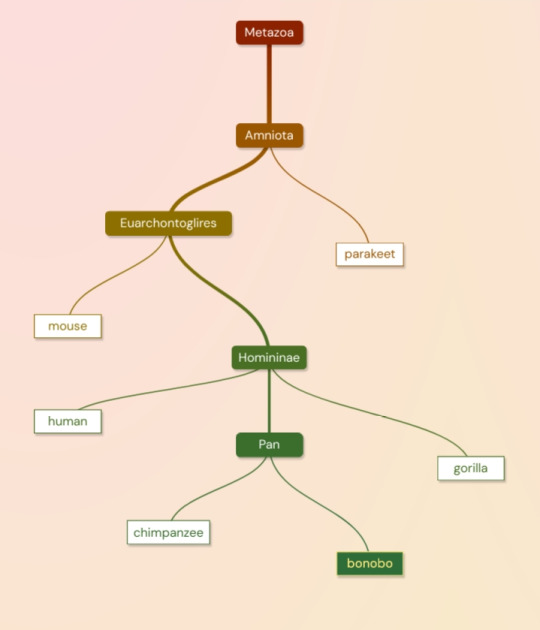
[ID: The metazooa, a cladistics puzzle tree, guessed in 6. Starting with parakett under amniota, then mouse under euarchontoglires. Under homininae is human then gorilla. And finally under pan is chimpanzee then the answer, bonobo. END]
like. they did some monty hall shit to me
Pan (genus)
The genus Pan consists of two extant species: the chimpanzee and the bonobo. Taxonomically, these two ape species are collectively termed panins.
good on me for specificity? completionism?
8 notes
·
View notes
Text

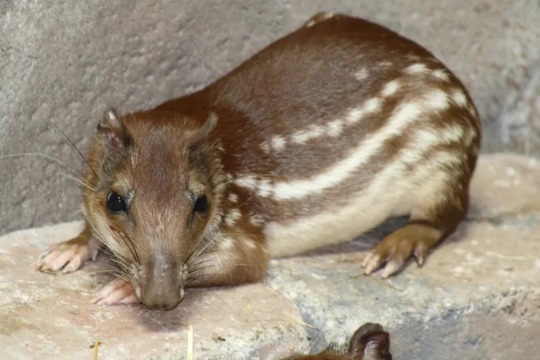
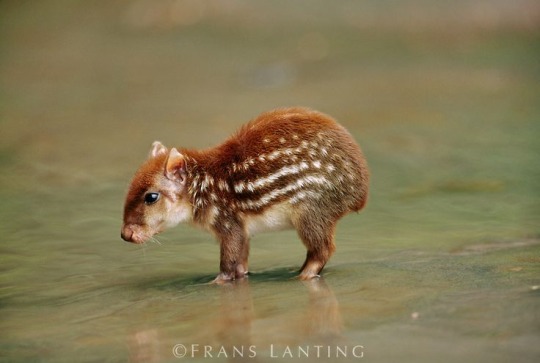
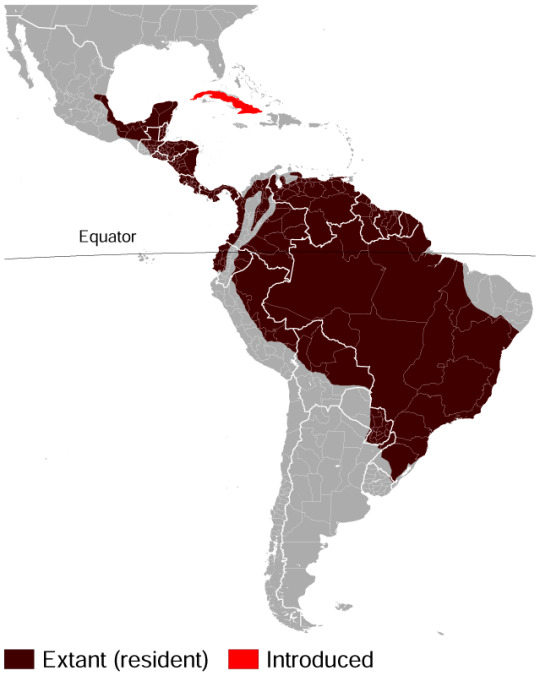
Lowland paca
Cuniculus paca
Family Cuniculidae, pavorder Caviomorpha, suborder Hystricomorpha, order Rodentia
Also known as the spotted paca, tepezcuintle, guardatinaja, pisquinte, jaleb, conejo pintado, guanta, majás, picuro, jochi pintado, boruga, tinajo, guartinaja, gibnut, labba, lapa, and lappe.
There is another animal with a similar name, the Pacarana. But these are not the same animal. They simply have similar appearances.
They are mainly quiet and nocturnal. They dig burrows about 2 metres below the surface with usually more than one exit and are great climbers and swimmers.
They will often seek water to escape predation as they can hold their breaths for several minutes.
They are omnivorous and important seed dispersers. They love fruit and will also eat stems, leaves, tubers, roots, nuts, seeds, and herbs.
They will also eat from carcasses to supplement protein. They eat flesh less often than plants though. They lean more towards herbivorous in the wild and omnivorous in captivity, but have been known to eat flesh in the wild.
There is some conflicting information about their social structure with some sources saying they are largely solitary, and others saying that they are monotonous and form small family groups. Caring for young anywhere from 8 weeks to 6 months.
@jackalspine @fifiibibii
22 notes
·
View notes
Text
moles != rodents

Re: mole classification
This tree isn't totally up to date and indeed these high level relationships remain hard to figure out, but the orange (Laurasiatheria) and blue (Euarchontoglires) groupings are overall correct, and rodents and moles (in the group Eulipotyphia) are not close at all. Rodents are closer to rabbits and primates than to moles, and moles are closer to hoofed mammals and dogs than to rodents.
#taxonomy#phylogeny#clades#Eulipotyphia#mole interest#my posts#Eulipotyphla means 'truly fat and blind'#it includes moles hedgehogs shrews solenodons desmans and moonrats#(and they aren't blind generally)
9 notes
·
View notes
Text
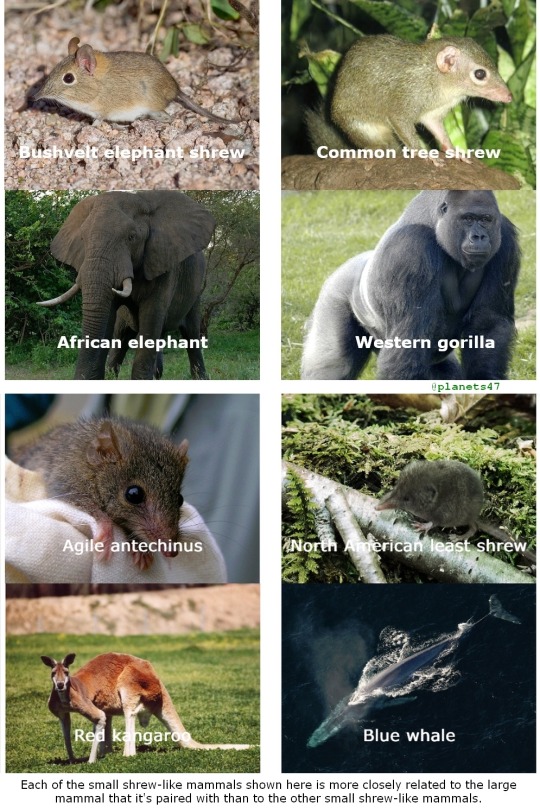
Paired photographs of elephant shrew with elephant; tree shrew with gorilla; antechinus with kangaroo; true shrew with blue whale. Caption: “Each of the small shrew-like mammals shown here is more closely related to the large mammal that it's paired with than to the other small shrew-like mammals.”
In this context "is more closedly related to" means "has a more recent common ancestor with.”
Elephant and elephant shrew represent clade Afrotheria; gorilla and tree shrew, Euarchontoglires; kangaroo and antechinus, Marsupialia; whale and true shrew, Laurasiatheria.
5 notes
·
View notes
Text
Okay the clade that groups us and rats together is called Euarchontoglires, which means science needs to stop trying to turn a chicken into a T-rex when we could have the Rat Man™
9 notes
·
View notes